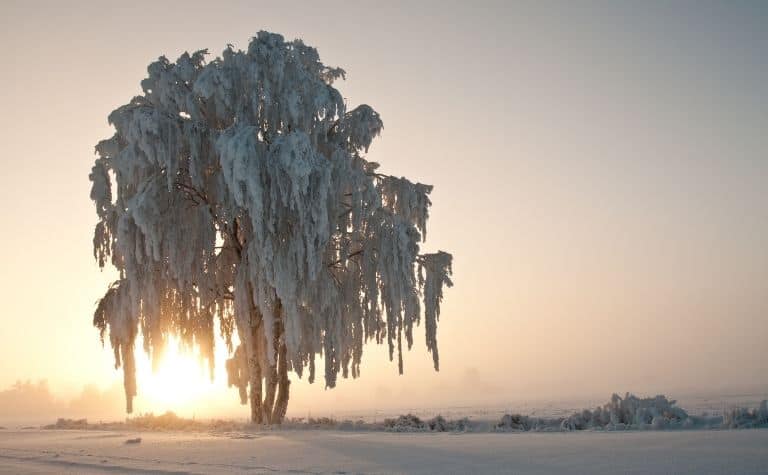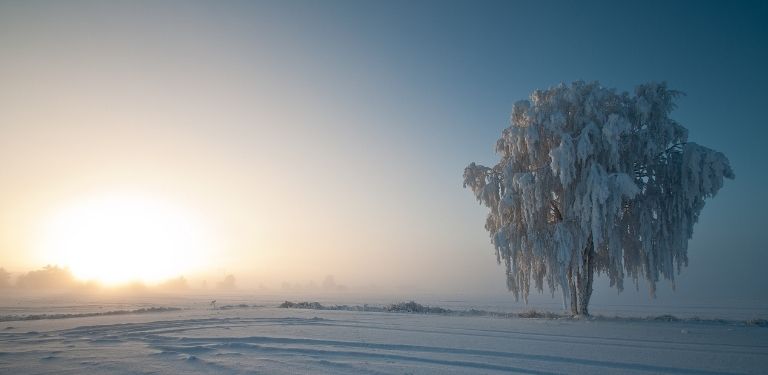Norse mythology is a colorful tapestry weaving together larger-than-life figures, rousing tales, and transcendent themes that attempt to explain the cosmos and the human condition through the Viking lens.
It is also full of symbols, and perhaps none is more significant in the minds and hearts of the Scandinavian people who lived during the Viking Age than Yggdrasil, the Norse tree of life.
According to Norse mythology, the Norse tree of life lies at the center of the universe, and the nine realms that constitute the cosmos hang from its branches.
There are themes of creation and sustenance associated with Yggdrasil, but in classic Viking fashion, it is also tied to death and chaos.
The Norse Tree of Life is a symbol with far-reaching significance, touching on virtually every aspect of the Vikings’ existence.
It provides structure and a sense of order in the universe while delineating the different realms and providing conceptual boundaries.
Ultimately, Yggdrasil stands for life and rebirth, but only after the mighty ash is shaken to its core, teetering on the edge of destruction, and here’s how.

Is the Viking Ash Tree Real?
The Norse Tree of Life is described as an evergreen ash tree of inconceivable proportions. [1] Its mighty branches support the nine realms of the Norse cosmos, including:
- Midgard, the realm of humankind
- Asgard, home to the gods (Also see Asgard vs. Valhalla: What’s the Difference?)
Like similar tree motifs in other mythologies, Yggdrasil is a spiritual metaphor serving as a pillar upon which other fundamental beliefs are supported.
Despite being a mythological construct, the Yggdrasil does have arboreal attributes, including:
- Branches that support the nine realms of the Norse cosmos
- Roots that extend down into the realms of Helheim, Jotunheim, and Asgard
- A trunk that supports the branches and connects the tree to its roots
The concept of a life-sustaining tree taking on an important symbolic role can also be found in other pagan civilizations, namely the Germanic tribes that preceded the Vikings. (Also see Did the Vikings Worship Odin?)
For instance, a real-life tree named Irminsul was worshiped by clans in Saxony, Germany, before it was felled by Charlemagne in the 8th century during the Saxon Wars, presumably to demoralize them as battles raged.
A bit closer to home, a famed evergreen tree (presumably also an ash tree) located within the Uppsala Temple site in Sweden was deeply revered by ancient worshipers and represented an earthly manifestation of Yggdrasil from mythic lore. [2] (Also see Is Norse Mythology Older Than Christianity?)
In a similar fashion, Viking settlements were often laid out around a single, large tree to mimic, in their realm, the sacred essence of the Norse tree of life.

What Did the Tree of Life Mean to the Vikings?
As one of the most deeply revered and widely worshiped symbols of Norse mythology, the Tree of Life has numerous meanings.
Like the all-father Odin, whose many names are indicative of the various roles he played in the eyes of the Norse people, Yggdrasil is a powerful spiritual motif representing a range of fundamental Viking beliefs about life and the universe.
The Tree of Life Represents Order and Structure
Through the eyes of the Vikings, the Norse tree of life lies at the center of the cosmos. It is the axis mundi or the axis around which the Norse universe revolves. [3]
It is also the unifying force that holds the universe together, providing order and stability between and among the different realms (of which there are nine) that are supported by its trunk and branches. (Also see Norse Mythology vs Egyptian Mythology: What’s the Difference?)
Aside from serving as a cosmic foundation upon which the various realms rest, Yggdrasil also defines and establishes boundaries between them.
Each domain in the Norse universe has its place in relation to the others thanks to the Norse tree of life, including most notably:
- Asgard, the realm of the Aesir gods, is most often described as occupying the upper reaches of Yggdrasil alongside Vanaheim, home of the Vanir gods
- Midgard, the earthly world inhabited by humans, is said to encircle the main trunk of the Tree of Life
- The Norse underworld, including Niflheim and Helheim, the realm of the dead, lies among the roots of Yggdrasil
Thus, not only does the Tree of Life contain the cosmos, but it also provides order and structure within the universe.
The Tree of Life Represents Knowledge and Destiny
As one of Norse mythology’s most prominent symbols, it comes as no surprise that the Norse god with which it is most closely associated is none other than the all-father himself, Odin.
In fact, it is widely accepted that the name of the tree of life, Yggdrasil, means “Horse of Odin” and derives from the Old Norse terms:
- Yggr, meaning “terror,” which is one of Odin’s many monikers
- Drasill, meaning “horse” (but interpreted in this instance to mean gallows) [4]
When taken together, Yggdrasil is the tree from which Odin hung himself for nine days and nine nights in an excruciating act of self-sacrifice in order to unlock the secrets of ancient runes and gain an understanding of their meaning.
The tree of life is also strongly linked to the concept of destiny, as the three Norns (spirits who control the fates of gods and humans) dwell among Yggdrasil’s roots and foretell future events by inscribing them in the form of runes into the ash tree’s bark. (Also see This Is Why Odin Sacrificed His Eye)
The Tree of Life Stands for Life and Rebirth
Among the most compelling narratives in Norse mythology are the arrival of Ragnarok and the cataclysmic battle that occurs between Odin and his fellow gods on one side and Loki and all manner of giants on the other.
Aside from being the ultimate conflict between order and chaos, Ragnarok is symbolic of the cyclical end of all living things through death and destruction. But it also stands for hope and rebirth. [5]
As the mighty ash tree, Yggdrasil demonstrates, from the ruins of worlds laid bare by Ragnarok, arises a new beginning.
The rebirth of the cosmos begins with Lif and Lifthrasir, two humans who hide themselves deep within the Tree of Life and emerge to a universe where chaos is at last vanquished.
Alongside a handful of gods who survive the carnage (sadly, Odin, Thor, and a host of Aesirs and Vanirs do not survive Ragnarok), Lif and Lifthrasir are tasked with rebuilding lost worlds and repopulating them with new generations of gods and humans.
And still standing as a source of inspiration is the Tree of Life. (Also see Is the Kraken a Myth?)
Is the Tree of Life Symbol Celtic or Norse?
The Viking influence is strong throughout Western Europe, including significant portions of England, Scotland, and Ireland, where Norse conquerors eventually became settlers, leaving their indelible marks on the people of these nations and their respective cultures.
In Ireland, for instance, the Vikings established settlements that eventually became thriving trading hubs. [6] Many of these commercial centers still exist to this day as modern towns and cities, including:
- Cork
- Dublin
- Limerick
- Waterford
- Wexford
The conquering Norsemen even impacted Celtic spiritual practices. There are significant parallels between Norse mythology and the old Celtic religions of the Irish and Scottish people, most notably in the things they revered and worshiped. (Also see Norse Mythology vs Greek Mythology: What’s the Difference?)
For instance, the Crann Bethadh, or the Celtic tree of life, has historically been one of the most important symbols of the Celts, representing balance and harmony in the natural world. [7]
It is believed that the ancient Celtic people adopted their Crann Bethadh from Yggdrasil, the Norse tree of life. [8]
The Celts put their own unique spin on the symbol by weaving the network of branches above with the criss-cross maze of roots down below to form a complex latticework pattern encircling the entire tree.
This interlacing motif is symbolic of the Celtic view that life is but a part of a never-ending cosmic cycle. [9]
Conclusion
The Norse Tree of Life is a powerful symbol representing the fragility of balance in the cosmos and hope that from chaos, order ultimately emerges.
References:
[1] Source
[2] Source
[3] Source
[4] Source
[5] Source
[6] Source
[7] Source
[8] Source
[9] Source
